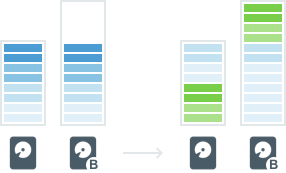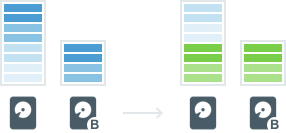DW Spectrum User Manual
Some disks on a server can be designated as backup storage. They will store a copy of the archives recorded to the main storage on the same server.
 Note: Only archives from main storage of a given server will be backed up. If there is archive on some other server you want to backup, you should configure backup storage for that server as well.
Note: Only archives from main storage of a given server will be backed up. If there is archive on some other server you want to backup, you should configure backup storage for that server as well.
With Backups enabled, the bandwidth restrictions can be configured in three ways: No Limit, Schedule, or Fixed (see "Configuring Backup and Redundant Storage" for details).
|
|
Because large amounts of data are being copied during backup, it is possible to set bandwidth limitations or to schedule regular backups at specific times (i.e. schedule), to minimize the negative impact of loading the network.
With the No Limit bandwidth option enabled, existing archive will be backed up. Afterward, live streams will be continuously recorded in backup storage.

Outdated archive is deleted from backup drives in the same way as from main ones, but independently of the main storage. In other words, if the backup storage has higher capacity, the maximum archive age on it will also be greater.

The opposite is also true – if backup storage is smaller, archive age will be less.

In order to save storage space, a System can be configured to backup only archive from certain cameras or only certain streams (see Configuring Backup and Redundant Storage for details). Camera recording is backed up only if the camera is selected in backup settings and backup storage is configured on the server that camera is currently connected to.





